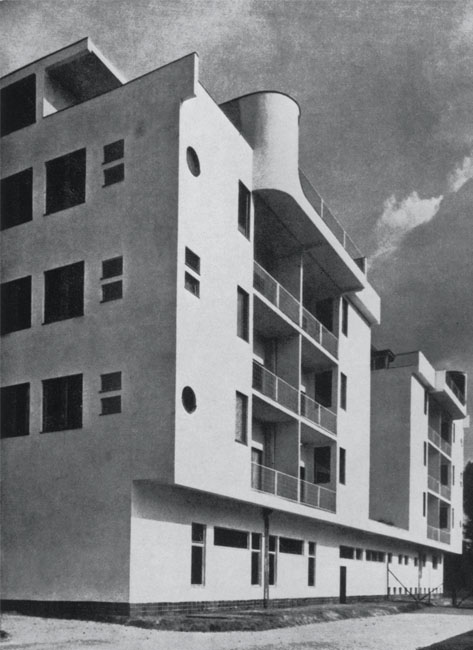Wohnturmhaus Wrocław
Adolf Rading
Samenvatting
Vanwege de enorme woningnood in Duitsland, midden jaren twintig, zagen architecten zich voor een opgave gesteld die zich vooral richtte op het ontwerp van woonwijken met Kleinwohnungen für grosse Familien. Men zocht naar nieuwe woonvormen en het bouwproces werd gerationaliseerd. Naast de ontwikkeling van standaard bouwelementen werden woningplattegronden uit kostenoverwegingen geminimaliseerd en opnieuw uitgedacht. Twee jaar na de Werkbundausstellung ‘Die Wohnung’ in Stuttgart (Weißenhofsiedlung) werd op 15 juni 1929 in Breslau (nu Wroclaw, Polen) de tentoonstelling ‘Wohnung und Werkraum’ geopend. Eén van de onderdelen van de tentoonstelling was de bouw van modelwijk Grüneiche. Naast functionele oplossingen voor kleine appartementen en eengezinswoningen, toont de Breslau-tentoonstelling ook twee vooruitstrevende modellen voor meer collectieve woonvormen. Hans Scharoun realiseert het ‘Ledigenwohnheim’, een woongebouw voor jonge stellen en alleenstaanden, en Adolf Rading bouwt een experimenteel appartementengebouw voor gezinnen.
Rading ging bij dit als hoogbouw geplande, maar slechts in vijf bouwlagen uitgevoerde ‘Wohnturmhaus’ uit van de gedachte dat de individuele woning weinig oppervlak nodig heeft, als er voor de bewoners (voldoende) gemeenschappelijke voorzieningen aangeboden worden. Het gebouw heeft een staalskelet, dat elke woning een andere indeling biedt. Op iedere verdieping zijn acht kleine appartementen ondergebracht, gegroepeerd in clusters van vier, verbonden met elkaar door middel van een 3,5 m brede en 40 m lange corridor. Door deze configuratie is iedere woning een hoekwoning die van twee kanten daglicht krijgt. Aan de uiteinden van elke gang bevinden zich gemeenschappelijke ruimten, die op de eerste verdieping dubbelhoog gemaakt zijn. De ruimten konden, net als de brede corridor zelf, overdag als speelplek voor kinderen en ‘s avonds door volwassenen gebruikt worden. Ook de dakverdieping met terrassen, ateliers en wasruimten waren voor collectief gebruik bedoeld. Rading was van mening dat de leefruimte (woonkamer) een centrale plek moest innemen in het huishouden en daarmee ook in de plattegrond. Voorzieningen als keuken en badkamer schoof hij daarom naar de hoekpunten. Door op het oppervlak van slaapruimten en voorzieningen te besparen (in sommige plattegronden is de slaapkamer niet meer dan een nis), is de woonkamer in deze kleine woningen toch nog relatief groot. Tegenwoordig wonen er in het gebouw studenten. Aan een zijde is de open ruimte tussen de twee gebouwdelen dichtgebouwd ten gunste van extra appartementen, die nu op elke verdieping gelijk zijn.



